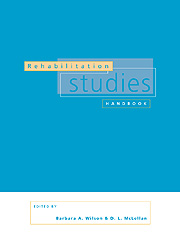Book contents
- Frontmatter
- Contents
- List of contributors
- 1 Introduction to rehabilitation
- 2 Disabled people in society
- 3 Disability equality training
- 4 Towards a therapeutic alliance model of rehabilitation
- 5 Rehabilitation education: a learner-centred approach
- 6 Work, occupation and disability
- 7 Management in rehabilitation
- 8 Research and evaluation in rehabilitation
- 9 Statistical methods
- 10 Social policy, disability and rehabilitation
- 11 Principles of the acquisition of sensorimotor skills
- 12 Management of acquired cognitive disorders
- 13 Challenging behaviour: helping people with severe brain damage
- 14 Pain
- 15 The multiply handicapped child
- 16 The transition to adult life
- 17 Factors specific to disabled elderly people
- Index
11 - Principles of the acquisition of sensorimotor skills
Published online by Cambridge University Press: 06 November 2009
- Frontmatter
- Contents
- List of contributors
- 1 Introduction to rehabilitation
- 2 Disabled people in society
- 3 Disability equality training
- 4 Towards a therapeutic alliance model of rehabilitation
- 5 Rehabilitation education: a learner-centred approach
- 6 Work, occupation and disability
- 7 Management in rehabilitation
- 8 Research and evaluation in rehabilitation
- 9 Statistical methods
- 10 Social policy, disability and rehabilitation
- 11 Principles of the acquisition of sensorimotor skills
- 12 Management of acquired cognitive disorders
- 13 Challenging behaviour: helping people with severe brain damage
- 14 Pain
- 15 The multiply handicapped child
- 16 The transition to adult life
- 17 Factors specific to disabled elderly people
- Index
Summary
Introduction
Learning, the acquisition of cognitive skills and the acquisition of sensorimotor skills are all functions of the brain. Although it is convenient to separate them when discussing the range of activities encountered in rehabilitation, the mechanisms involved are likely to have many similarities and to overlap with each other. The term ‘sensorimotor’ has been chosen rather than ‘motor’ to emphasise the importance of the integration of sensory and motor activity in all motor skills. All require feedback of performance detected through sensory mechanisms such as touch, pressure, joint position, velocity of movement, muscle tension, vision and hearing. Even at a neuronal level, there are individual neurones which fire under a range of such highly specific conditions that their function cannot be categorised as exclusively motor or exclusively sensory (Jeannerod, 1994).
This chapter will concentrate on sensorimotor skill as a practical and clinical phenomenon in rehabilitation, and a priority for rehabilitation research. Schmidt's ‘Motor Control and Learning’ (1988) is recommended reading for those wishing to pursue this topic in more depth; further suggestions will be found in the bibliography at the end of the chapter.
The final common path of any movement is activation of motor neurones producing a particular pattern of muscular contraction and (as appropriate) movement of joints. Some aspects of motor performance will depend on the integrity and efficiency of these physiological and biomechanical processes. Many other factors that affect performance reside with the central nervous system (CNS) and skill is only one of these. Separating fluctuations of performance from the presence or absence of skill is one of the fundamental conceptual and practical challenges of research into the acquisition of skill.
- Type
- Chapter
- Information
- Rehabilitation Studies Handbook , pp. 227 - 242Publisher: Cambridge University PressPrint publication year: 1997



